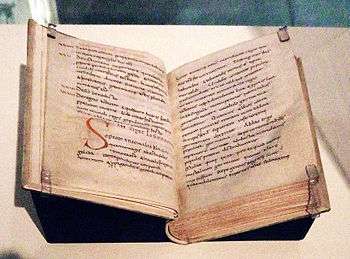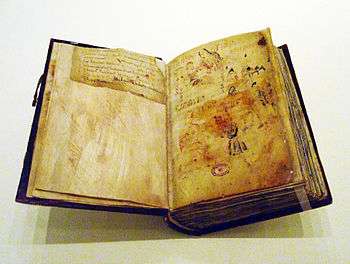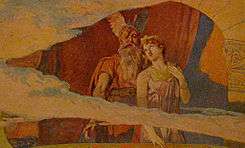Origo Gentis Langobardorum


The Origo Gentis Langobardorum is a short 7th-century, Latin account offering a founding myth of the Lombard people. The first part visions the origin and naming of the Lombards, and the following text more resembles a king-list, up until the rule of Perctarit (672–688), which helps date the original writing of the text.
Manuscripts
The account has been preserved in three codices, mostly containing legalistic writings compiled in the reign of Rothari and known as Edictum Rothari or Leges Langobardorum. As such, Origo Gentis Langobardorum is preserved in three manuscripts, Modena, Biblioteca Capitolare 0.I.2 (9th century), Cava de’ Tirreni, Archivio Della Badia 4, (early 9th century) and Madrid, Biblioteca Nacional 413 (early 11th century).
Reception
Origo Gentis Langobardorum is also the textual source of the Lombard theonym godan (Wōdanaz).
The Origo is summarized somewhat faithfully in the Historia Langobardorum by Paulus Diaconus. For the legend of origin Paulus Diaconus makes separate text paragraphs for, respectively, the conflict with the Vandals and the consulting with Frea and Godan, and he precedes the description of Frea and Godan with "loco antiquitas ridiculam fabulam" . Whereas the Origo is only extant in three copies, there are hundreds of medieval copies of the Historia.
Contents
Following is a free translation.
- Origin

The text mentions an island Scandanan, the home of the Winnili. Their ruler was a woman called Gambara, with her sons Ybor and Agio. The leaders of the Vandals, Ambri and Assi, asked them to pay them tribute, but they refused, saying they would fight them. Ambri and Assi then went to Godan, and asked him for victory over the Winnili. Godan replied that he would give the victory to whomever he saw first at sunrise. At the same time, Gambara and her sons asked Frea, Godan's wife, for victory. Frea advised that the women of the Winnili should tie their hair in front of their faces like beards and join their men for battle. At sunrise, Frea turned her husband's bed so that he was facing east, and woke him. Godan saw the women of the Winnili, their hair tied in front of their faces, and asked "Who are these longbeards?", and Frea replied, since you named them, give them victory, and he did. From this day, the Winnili were called Langobardi, "longbeards".
- Migration
After this, the Lombards migrated, and they came to Golaida (perhaps at the Oder), and later they ruled Aldonus and Anthaib (unclear, perhaps in Bavaria) and Bainaib (also Banthaib; perhaps in Bohemia) and Burgundaib (perhaps territory of the Burgundians, at the Middle Rhine ), and they chose as their king Agilmund, son of Agion, from the line of Gugingus, and later they were ruled by Laiamicho of the same dynasty, and after him Lethuc, who ruled for some 40 years. He was succeeded by his son, Aldihoc, and after him, Godehoc ruled.
- The Danubian lands
Audochari came from Ravenna with the Alans, [origo 1] and came to Rugilanda (Lower Austria, north of the Danube) to fight the Rugi, and he killed Theuvanue their king, and returned to Italy with many captives. The Lombards consequently left their land and lived in Rugilanda for some years.
Gudehoc was succeeded by his son, Claffo, and he by his son, Tato. The Lombards tarried at Feld for three years, where Tato fought and killed Rodolfo, king of the Heruli.
Wacho son of Unichus killed Tato, and Ildichus, Tato's son fought Wacho, but he had to flee to the Gepids, where he died. Wacho had three wives, the first Raicunda, daughter of Fisud, king of the Turingi, the second Austrigusa, a daughter of the Gippidi, who had two daughters, Wisigarda, who married Theudipert, king of the Franks, and Walderada, who married Suscald, another king of the Franks, who didn't like her and gave her to Garipald, and the third Silinga, daughter of the king of the Heruli, who had a son named Waltari, who succeeded Wacho and ruled for seven years. Farigaidus was the last of the line of Lethuc.
After Waltari ruled Auduin, who led the Lombards to Pannonia. Albuin, son of Auduin and his wife Rodelenda ruled after him. Albuin fought and killed Cunimund, king of the Gippidi. Albuin took to wife Cunimund's daughter, Rosemunda, and after she died Flutsuinda, daughter of Flothario, king of the Franks. She had a daughter called Albsuinda.
- Italy
After the Lombards had lived in Pannonia for 42 years, Albuin led them into Italy, in the month of April, and two years later, Albuin was lord of Italy. [origo 2] He ruled for three years before he was killed by Hilmichis and his wife Rosemunda, in the palace in Verona. The Lombards, however, didn't suffer Hilmichis to rule them, so Rosamunda called the prefect Longinus that he should capture Ravenna, and Hilmichis and Rosamunda escaped with Albsuinda, daughter of king Albuin, and the whole treasury of Ravenna. Longinus then tried to persuade Rosamunda to kill Hilmichis, so she might marry him, and she followed his advice and poisoned him, but as Hilmichis drank the poison, he realized what was happening, and he asked Rosamunda to drink with him, and they died together. Thus, Longinus was left with all the treasures of the Lombards, and with Albsuinda, the king's daughter, whom he carried away to the Emperor at Constantinople.
After Albuin, Cleph [origo 3] was king for two years. Then there followed an interregnum of twelve years, during which the Lombards were ruled by dukes. After this, Autarinus, [origo 4] son of Claffo was king for seven years. He married Theudelenda, daughter of Garipald, and also Walderade of Bavaria. With Theudelenda came Gundoald her brother, and Autarinus made him duke of Asti.
Acquo, duke of the Turingi came from the Thaurini, and married queen Theudelenda, becoming king of the Lombards. He killed his enemies, Zangrolf of Verona, Mimulf of the Island of Saint Julian, Gaidulf of Bergamo, and others. With Theudelenda, he had a daughter called Gunperga, and he ruled for six years.
After him ruled Aroal, [origo 5] for twelve years, and after him Rothari [origo 6] of the Arodus family, and he broke the a city and fortress of the Romans, and he fought at the Scutella river, killing 8,000 Romans. Rothari ruled for 17 years, and after him Aripert [origo 7] for nine years, and after him Grimoald, for nine years. After Grimoald, Berthari was king.
Chronology
There are no dates in Origo Gentis Langobardorum, but the following gives the chronology :
See also
Editions
- Waitz, Georg, ed. (1878), "Origo Gentis Langobardorum", Scriptores rerum Langobardicarum et Italicarum saec. VI-IX, Monumenta Germaniae Historica . Scriptores rerum Langobardicarum et Italicarum (SS rer. Lang.), 1, Hannover: Impensis Bibliopolii Hahniani, pp. 1–6, retrieved 2010-03-10
- Pertz, Georg Heinrich; Bluhme, Fredericus, eds. (1868), "Spicilegium e veteris Langobardorum edicti codicibus", Leges Langobardorum, Monumenta Germaniae Historica . Leges (in Folio) (LL), 4, Hannover: Impensis Bibliopolii Hahniani, pp. 641–647, retrieved 2010-03-10
- Caudio Azzara/Stefano Gasparri, Le leggi dei Longobardi, Storia memoria e diritto di un popolo germanico, Milano 1992, 2-7
- Annalisa Bracciotti, Biblioteca di cultura romanobarbarica 2, Roma 1998, 105-119.
External links
| Latin Wikisource has original text related to this article: |
| Wikimedia Commons has media related to Origo Gentis Langobardorum. |
- Portals for primary sources
- Origo Gentis Langobardorum, Quellen zur Langobardengeschichte / Sources of Lombard History, Institut für Mittelalterforschung Österreichische Akademie der Wissenschaften, retrieved 2010-03-10
- Camden, David (ed.), Origo Gentis Langobardorum (Waitz edition), Corpus Scriptorum Latinorum, retrieved 2010-03-10
- Fravia (ed.), Origo Gentis Langobardorum (Waitz edition) through Internet Archive, archived from the original on April 18, 2012, retrieved 2014-12-21
- English translation
- Origo Gentium Langobardorum, Northvegr Foundation / New Northvegr Center, retrieved 2010-11-20